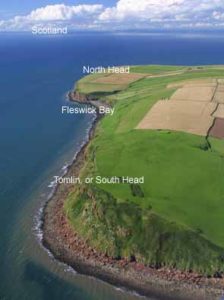The Geology of St Bees

The underlying rock is red Permo-triassic sandstone about 200 Million years old, which is known geologically as “St. Bees New Red Sandstone”. The St. Bees valley, which is much too big for the small “beck” that drains it, was formed by glacial action. The sandstone is never far from the surface and the smooth contours of the fields accurately reflect the underlying rock.
On the seaward side, the rock has been eroded by wave action to produce the spectacular 80 metre high vertical cliffs stretching from the Seacote foreshore to Saltom Bay, 4 miles to the North. The dramatic sandstone cliffs of St. Bees Head are a heritage coast, and have one of the largest seabird colonies in England. At Saltom there is an old alabaster mine and the geology changes to carboniferous sandstones.
At the west end of the St. Bees valley are the terminal moraines of the last glacier (12 – 14,000 years ago) which make an interesting golf Course. These unprotected cliffs are retreating at about 4 – 6 inches a year, and consequently this is one of the best places in England to look at a freshly-eroded cross-section of a glacial moraine. Several huge “erratics” are visible in the shingle.
Between the two heads there is Fleswick Bay, accessible only by boat or foot. It is a marvellous shingle beach laid on huge sandstone platforms, which has attracted many generations of amateur lapidarists. The strata of the cliffs are best seen from here or from a boat.

St Bees Bay, with the sandstone cliffs at the top, and the moraine cliffs to the right at the golf course.

Large sandstone face at North Head showing thick beds of red sandstone with thin strata of white sandstone.

Sandstone face at North Head showing weathering of the softer white sandstone.

Large boulders are released from the moraine cliffs as they are eroded by the sea. This is at Seamill beach.

Canyons” are formed in the higher moraine cliffs. Poor surface drainage due to large lodes of clay assists the erosion.

The huge variety of shingle on the beach is testimony to the distances this material was carried; from both Scotland and the Lakeland fells, and it is replenished by the continual erosion of the cliffs.

At the foot of the shingle the ancient peat beds containing petrified trees can be seen after a scouring tide.

